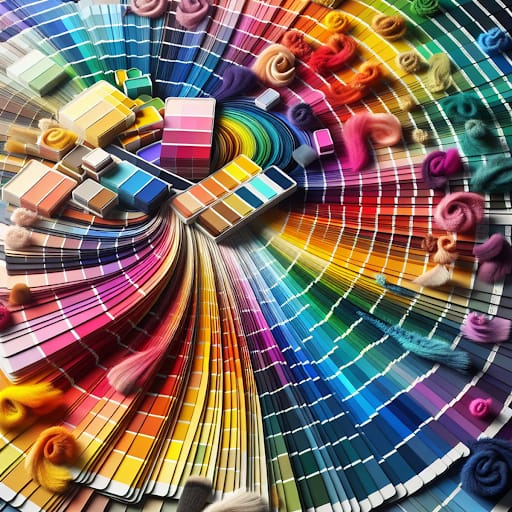Introduction
Color combinations play a crucial role in design, influencing how a project is perceived and remembered. The right color scheme can elevate your design, making it visually appealing and effective in communicating the intended message. On the other hand, poor color choices can take away from your work, leading to confusion and disengagement.
Color in design goes beyond just looks; it affects branding, web design, and packaging by evoking specific emotions and reactions. For example, blue often conveys trust and professionalism, making it a popular choice for corporate branding, while vibrant colors like red can create excitement and urgency.
In this article, we will explore 26 best color combinations that are widely used and highly effective across various design contexts:
- Branding: Establish a strong brand identity with the right color palette.
- Web Design: Enhance user experience and interface by utilizing appropriate color schemes.
- Packaging: Make products stand out on the shelves through strategic color selection.
Understanding these combinations will help you make better choices that improve the visual appeal and effectiveness of your designs.
For those looking to hire professional designers who can bring their vision to life, you may consider exploring platforms like Freelancing Web. These platforms provide access to a pool of talented web designers who can create sleek and professional websites using content management systems such as Squarespace with ease.
Understanding Color Theory and Its Application in Design
Basics of Color Theory
Color theory is essential for creating harmonious color combinations. To grasp this concept, it’s important to know the different categories of colors:
- Primary Colors: Red, blue, and yellow. These colors cannot be created by mixing other colors.
- Secondary Colors: Green, orange, and purple. These colors are formed by mixing primary colors.
- Tertiary Colors: Created by mixing a primary color with a secondary color.
Types of Color Schemes
Different types of color schemes help designers create visually appealing combinations:
- Analogous: Uses colors that are next to each other on the color wheel (e.g., blue, blue-green, and green). This scheme is harmonious and pleasing to the eye.
- Complementary: Combines colors opposite each other on the color wheel (e.g., blue and orange). This scheme creates high contrast and vibrant looks.
- Triadic: Involves three evenly spaced colors on the color wheel (e.g., red, yellow, and blue). This scheme offers a balanced yet colorful appearance.
The Color Wheel
The color wheel is a vital tool for designers. It visually represents:
- Hues: Pure colors like red, green, or blue.
- Shades: Darker versions of hues made by adding black.
- Tints: Lighter versions of hues made by adding white.
Using the Color Wheel Effectively
To choose colors that work well together:
- Identify your base color on the wheel.
- Select complementary or analogous colors depending on your desired effect.
- Adjust shades and tints to match your design’s mood and context.
Understanding these principles allows designers to craft visually compelling and effective designs across various mediums.
26 Best Color Combinations for Your Next Design
Choosing the right colors can make a world of difference in your design. It can take it from ordinary to extraordinary, from forgettable to memorable. But with so many colors out there, how do you know which ones work well together?
That’s where this list comes in. We’ve curated a selection of the best color combinations for you to use in your designs. Whether you’re working on a website, a logo, or any other visual project, these color palettes will help you create something stunning.
Each color combination comes with its hex codes (the codes used to represent colors on the web) and a brief description of the mood or feeling it evokes. Use these descriptions as a guide to find the right colors for your brand or message.
1. Classic Blue & White
Hex Codes: #0A74DA (Blue), #FFFFFF (White)
Description: Timeless and versatile, perfect for corporate branding and professional websites.
2. Black & Yellow
Hex Codes: #000000 (Black), #FFD700 (Yellow)
Description: Bold and eye-catching, suitable for high-impact marketing materials and sports branding.
3. Navy & Coral
Hex Codes: #2C3E50 (Navy), #FF6F61 (Coral)
Description: Elegant and modern, ideal for fashion websites and personal blogs.
4. Gray & Lime Green
Hex Codes: #7D7D7D (Gray), #32CD32 (Lime Green)
Description: Subtle yet vibrant, great for tech startups and eco-friendly brands.
5. Purple & Gold
Hex Codes: #800080 (Purple), #FFD700 (Gold)
Description: Luxurious and sophisticated, excellent for luxury products and high-end services.
6. Teal & Orange
Hex Codes: #008080 (Teal), #FFA500 (Orange)
Description: Fresh and energetic, perfect for travel websites and adventure brands.
7. Maroon & Cream
Hex Codes: #800000 (Maroon), #FFFDD0 (Cream)
Description: Warm and inviting, suitable for coffee shops and artisanal brands.
8. Mint Green & Black
Hex Codes: #98FF98 (Mint Green), #000000 (Black)
Description: Clean and modern, great for health and wellness sites.
9. Pink & Gray
Hex Codes: #FFC0CB (Pink), #808080 (Gray)
Description: Soft yet refined, ideal for beauty products and lifestyle blogs.
10. Red & White
Hex Codes: #FF0000 (Red), #FFFFFF (White)
Description: Bold and patriotic, perfect for national events and holiday promotions.
11. Turquoise & Purple
Hex Codes: #40E0D0 (Turquoise), #800080 (Purple)
Description: Vibrant and playful, suited for children’s products and creative agencies.
12. Olive Green & Beige
Hex Codes: #808000 (Olive Green), #F5F5DC (Beige)
Description: Earthy and calming, great for organic products and nature-focused brands.
13. Sky Blue & Peach
Hex Codes: #87CEEB (Sky Blue), #FFDAB9 (Peach)
Description: Light and airy, suitable for wedding websites and baby products.
14. Dark Green & Gold
Hex Codes: #006400 (Dark Green), #FFD700 (Gold)
Description: Rich and elegant, ideal for financial institutions and premium services.
15. Charcoal & Mustard Yellow
Hex Codes: #36454F (Charcoal), #FFDB58 (Mustard Yellow)
Description: Modern yet retro, perfect for vintage designs and hipster brands.
16. Lavender & Navy Blue
Hex Codes: #E6E6FA (Lavender), #000080 (Navy Blue)
Examples of Successful Designs with Impactful Color Combinations
Exploring real-world examples of labels and packaging designs that use the 26 curated color combinations can provide valuable insights. These examples not only show how colors are used effectively but also demonstrate the principles behind successful design.
1. Ocean Blue and Sandy Beige
- Example: A skincare brand uses ocean blue (#0077be) and sandy beige (#f5deb3) on their packaging.
- Elements Demonstrated:Contrast: The cool blue stands out against the warm beige, making text and graphics pop.
- Emotion: Creates a feeling of calm and relaxation, perfect for skincare products.
2. Forest Green and Crisp White
- Example: An organic food brand uses forest green (#228b22) and crisp white (#ffffff) on their product labels.
- Elements Demonstrated:Harmony: The green represents nature and health, while white gives a clean, fresh look.
- Readability: High contrast makes sure that important information is easy to read.
3. Vibrant Red and Classic Black
- Example: A luxury wine label uses vibrant red (#b22222) paired with classic black (#000000).
- Elements Demonstrated:Elegance: Red accents on a black background create a sophisticated look.
- Attention-Grabbing: The bold red draws attention to key elements like the brand name.
4. Sunset Orange and Soft Lavender
- Example: A candle company uses sunset orange (#ff4500) and soft lavender (#e6e6fa) in their packaging.
- Elements Demonstrated:Warmth: Orange suggests warmth and comfort, perfect for candles.
- Balance: Lavender balances the brightness of orange, creating a soothing look.
5. Bold Purple and Sunny Yellow
- Example: A children’s toy brand uses bold purple (#800080) combined with sunny yellow (#ffd700).
- Elements Demonstrated:Playfulness: The combination adds energy and fun to the design.
- Visibility: Bright colors make sure that the product stands out on shelves.
These examples show how careful color combinations can improve a design. They highlight several important principles:
Contrast & Harmony: Balancing contrasting colors while maintaining harmony ensures that designs are both eye-catching and aesthetically pleasing.
Emotion & Message: Colors are powerful communicators of emotion. Choosing colors that align with your brand’s message enhances the overall impact.
Readability & Focus: Selecting color combinations that enhance readability ensures that important information is conveyed effectively.
Designers can get inspiration from these successful examples to create their own unique color palettes for different projects like branding, web design, or packaging.
Conclusion
The right color combinations have the power to:
Evoke Emotions: Colors like blue can create a feeling of calm and trust, while red can generate excitement and urgency. By using these colors strategically, you can influence how your audience feels.
Communicate Messages: Green often represents growth and sustainability, making it a great choice for eco-friendly brands. On the other hand, black conveys luxury and sophistication, which is perfect for high-end products.
Create Memorable Experiences: Using unique color combinations helps designs stand out. Whether it’s through contrasting or harmonizing shades, this ensures that your work leaves a lasting impression.
With this curated list of 26 best color combinations, designers are encouraged to:
Take bold steps in incorporating diverse colors into their projects.
Understand that while this list provides valuable insights, there are endless possibilities for color combinations.
Trust their instincts and unique vision when it comes to discovering what works best for each specific design context.
Remember, color is just one aspect of design. It’s important to consider other elements such as typography, layout, and imagery to create a cohesive visual identity.
So go ahead, experiment with colors, and let your creativity shine!
“Colors speak louder than words.” – John Saddington
Hire Professional Designers for Your Next Project
Professional designers bring a wealth of expertise in color theory and can make a significant impact with their thoughtful use of color combinations. Their skills transform ordinary designs into visually stunning and effective creations.
Why Hire Freelance Designers Through Freelancing Web?
Access to a Diverse Pool of Talent: Connect with experienced designers who specialize in various design fields, ensuring you find the perfect match for your project.
Cost-Effectiveness: Enjoy the benefits of top-tier design services without the high costs associated with traditional agencies.
Faster Turnaround Times: Freelancers often provide quicker delivery, allowing you to meet tight deadlines efficiently.
Explore our Freelancing Web’s design services and discover the vast potential of hiring freelance designers. Their strategic use of color can elevate your designs, making them not only appealing but also memorable.
Ready to Transform Your Project?
Empower your business with the right talent today!
FAQs (Frequently Asked Questions)
What is the importance of color in design?
Color plays a crucial role in design as it has the power to make or break a project. It can evoke emotions, communicate messages, and create memorable experiences for the audience.
What will be explored in this article?
In this article, we will explore 26 best color combinations that are widely used and highly effective in various design contexts such as branding, web design, and packaging.
What are the basics of color theory?
The basics of color theory include understanding primary, secondary, and tertiary colors, as well as different types of color schemes such as analogous, complementary, and triadic.
How can designers effectively choose colors for their designs?
Designers can effectively choose colors by using the color wheel as a visual tool to navigate through various hues, shades, and tints.
Where can readers find examples of successful designs with impactful color combinations?
Readers can find examples of successful designs with impactful color combinations in real-world labels and packaging designs showcased in this article.
Why is it important to hire professional designers for a project?
Professional designers can make a significant impact with their expertise in color theory and thoughtful use of color combinations. They bring valuable insights and unique vision to design projects.





